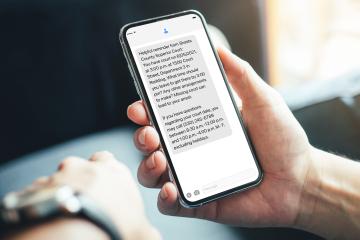
The effect of nudges on federal student aid take-up in the United States

Summary
In the United States, post-secondary education is a key pathway to economic and social mobility. However, a recent survey found that 38 percent of prospective students did not attend or complete college due to costs.1 Evidence shows that financial support can increase enrollment and degree attainment, yet public student aid tends to be underutilized.23 In 2021, approximately US$3.75 billion earmarked for Pell Grants (federal education grants for low-income students) went unclaimed.4 To access Pell Grants and other forms of federal student aid, students must complete the Free Application for Federal Student Aid (FAFSA)—an application that has been criticized as complex and difficult.5 Some students have family members who can help guide them through the process, but others may lack the necessary information and support to navigate the FAFSA’s administrative burdens. Efforts to increase FAFSA filing therefore focus on helping students overcome these burdens.
This insight reviews seven randomized evaluations of interventions aiming to increase FAFSA filing in the United States[1][2][3][4][5][6][7]. While solely providing information about the FAFSA does not impact filing, [2][3][4] personalized and timely nudges can be effective [1][5][7]. However, the impacts of nudges are inconsistent at scale, with some studies demonstrating positive outcomes [7] and others finding no impacts [1][4][6]. Compared to nudges, hands-on assistance can increase FAFSA filing rates and financial aid receipt at a larger magnitude [3].
Supporting evidence
Providing information alone is generally insufficient to increase FAFSA filing. In two studies, providing students with information about the FAFSA had no impact on filing [2][3]. In Texas, prospective college students—high schoolers, current college students, and people who had applied but not enrolled—received generic (i.e., not personalized) information about filing the FAFSA, either in combination with information on other tax benefits of college enrollment or on its own. Prospective students who received information about the FAFSA were no more likely to receive financial aid (the researchers’ proxy for filing the FAFSA) than those who did not. Emails about the FAFSA also had no effect on college enrollment among high school students [2]. In Ohio and North Carolina, receiving information about the FAFSA, including a one-time personalized estimate of financial aid eligibility, did not impact FAFSA filing nor college enrollment among high school seniors and recent graduates [3].
Nudge reminders about FAFSA filing have positive impacts, particularly when messaging is personalized and timely. Three evaluations show that nudges can yield positive impacts on FAFSA filing and other college-going activities [1][5][7]. A Texas study on high schoolers in Austin and Houston found that weekly texts from high school counselors—containing both generic and personalized information about the FAFSA—increased FAFSA submission by 6 percentage points from a baseline of 40 percent (a 15 percent increase) [7]. Texts were sent in the second half of students’ senior year to proactively mitigate “summer melt” and promote early filing, giving students extra time to navigate the verification process, if applicable.
A text-based intervention among first year college students in Massachusetts increased college retention for community college students by 13.8 percentage points (an increase of 25.5 percent from a baseline of 54.1) [5]. Students received twelve personalized text messages between January and August containing information and reminders about the FAFSA as well as the offer of personalized assistance. Take-up of assistance was 108.5 percent higher among community college students who received texts (12.3 percent) than community college students in the comparison group (5.9 percent), suggesting that, among current students, texts may be a promising avenue for further engagement.
The impacts of nudges fizzle over time and often have no effect at scale. Despite some promising results of nudge interventions, four studies show that nudges may lose salience over time and/or be ineffective at scale [1][4][6][7]. For example, in a national study, college students were sent informational text messages in one of four varieties: basic framing, a social pressure framing, commitment device framing, or basic framing plus the offer to meet with an advisor [6]. Among students who had not filled out the FAFSA prior to the start of the intervention, receiving any text led to small (0.6–2.1 percentage point) increases in FAFSA filing for most of the first twelve weeks of the intervention. However, the impacts on filing rates disappeared by week thirteen. Researchers posit that these small and attenuating impacts may be due to timing (the intervention ended in the spring and did not continue through the summer), lack of familiarity or relationship between the texter and the student, and/or that messages were not personalized to students.
In addition, the increases in FAFSA submissions noted by the aforementioned Texas study attenuated in the months following the text-based intervention [7]. An evaluation of a similar text-based intervention at a national scale (70,000 students across fifteen states) found that receiving text messages had no impact on FAFSA filing [1].Unlike the texts in the Texas study, which came from high-school counselors, the texts in the national study were from a College Board representative. The lack of personal connection with the messenger may have played a role in these differential impacts.
Two large-scale evaluations nudging 800,000 prospective FAFSA filers had no impact on either financial aid outcomes or college enrollment [4]. Non-personalized messages to a national sample of low-income high school seniors had no impact on FAFSA filing regardless of the message’s framing (focused on the benefits of filing, positive norms around filing, or plans for filing), delivery method (i.e., mail, email, or text), or whether it offered one-on-one advising. Similarly, students and prospective students who received informational text messages about the FAFSA saw no improvements in filing even across variations in messaging and timing.
Initial evidence demonstrates that hands-on assistance yields large increases in FAFSA filing. In Ohio and North Carolina, the tax-preparation company H&R Block provided high school seniors, recent high school graduates, and/or their families with either a brochure about college, personalized information about the FAFSA, or personalized information about the FAFSA with hands-on filing assistance. A randomized evaluation of these offerings demonstrated that while information alone did not improve filing rates, information coupled with hands-on support had several positive impacts [3]. Among students financially dependent on their families (“dependents”), hands-on assistance increased filing by 15.7 percentage points compared to a baseline of 39.9 percent (a 39.3 percent increase). Among students who were financially independent from their families (“independents”), filing increased by 19.5 percentage points if they had previously taken college courses (from a baseline of 32 percent) and 26.7 percentage points if they had never attended any college (from a baseline of 16.1 percent). Hands-on assistance also led to larger financial aid packages, particularly for dependent students, and higher rates of enrollment. College enrollment increased by 8.1 percentage points (from a baseline of 34.2 percent) for dependent participants and by 1.5 percentage points (from 9.5 percent) for independent participants without college experience. Researchers suggest that these increases in enrollment may have contributed to the increases in financial aid awards.
Weissman, Sara. 2022. “New Study Explores Why People Drop out or Don’t Enroll.” Inside Higher Ed. https://www.insidehighered.com/news/2022/09/29/new-study-explores-why-people-drop-out-or-dont-enroll.
Angrist, Joshua, David Autor, and Amanda Pallais. "Marginal effects of merit aid for low-income students." The Quarterly Journal of Economics 137, no. 2 (2022): 1039-1090.
Angrist, Josh, David Autor, Sally Hudson, and Amanda Pallais. "Updated Results from a Randomized Evaluation of Post-Secondary Aid." (2016).
“NCAN Report: $3.75 Billion in Pell Grants Goes Unclaimed for High School Class of 2021 - National College Attainment Network.” NCAN. https://www.ncan.org/news/592984/NCAN-Report-3.75-Billion-in-Pell-Grants-Goes-Unclaimed-for-High-School-Class-of-2021.htm.
Jaschik, Scott. 2021. “Why Students Don’t Fill out the FAFSA | inside Higher Ed.” Inside Higher Ed. https://www.insidehighered.com/admissions/article/2021/04/12/why-students-dont-fill-out-fafsa.
Avery, Christopher, Benjamin L. Castleman, Michael Hurwitz, Bridget Terry Long, and Lindsay C. Page. "Digital messaging to improve college enrollment and success." Economics of Education Review 84 (2021): 102170.
Research Paper
Bergman, Peter, Jeffrey T. Denning, and Dayanand Manoli. "Is information enough? The effect of information about education tax benefits on student outcomes." Journal of Policy Analysis and Management 38, no. 3 (2019): 706-731.
Evaluation Summary | Research Paper
Bettinger, Eric P., Bridget Terry Long, Philip Oreopoulos, and Lisa Sanbonmatsu. "The role of application assistance and information in college decisions: Results from the H&R Block FAFSA experiment." The Quarterly Journal of Economics 127, no. 3 (2012): 1205-1242.
Evaluation Summary | Research Paper
Bird, Kelli A., Benjamin L. Castleman, Jeffrey T. Denning, Joshua Goodman, Cait Lamberton, and Kelly Ochs Rosinger. "Nudging at scale: Experimental evidence from FAFSA completion campaigns." Journal of Economic Behavior & Organization 183 (2021): 105-128.
Research Paper
Castleman, Benjamin L., and Lindsay C. Page. "Freshman year financial aid nudges: An experiment to increase FAFSA renewal and college persistence." Journal of Human Resources 51, no. 2 (2016): 389-415.
Research Paper
Page, Lindsay C., Bruce I. Sacerdote, Sara Goldrick-Rab, and Benjamin L. Castleman. "Financial aid nudges: A national experiment with informational interventions." Educational Evaluation and Policy Analysis (2022): 01623737221111403.
Research Paper
Page, Lindsay C., Benjamin L. Castleman, and Katharine Meyer. "Customized nudging to improve FAFSA completion and income verification." Educational Evaluation and Policy Analysis 42, no. 1 (2020): 3-21.
Research Paper

